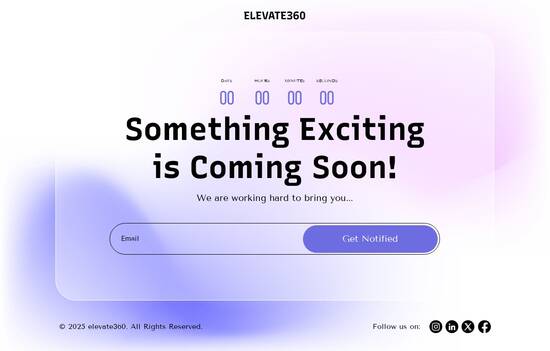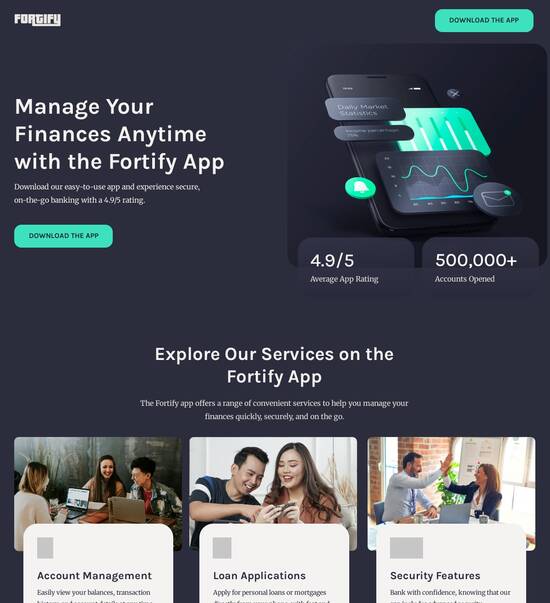
Email capture page template for beta testers
Explore Similar TemplatesAbout template
No matter your background, you can easily build landing pages. Simply find the right email capture page template for beta testers and adjust it to your needs!
Recommended templates

Easy to build without coding
With the intuitive drag-and-drop builder, anyone on your team can create high-converting pages without any knowledge of code or design. Make enhancements to your landing page with custom widgets using Javascript, HTML/CSS, or third-party scripts.

Multiple layouts for any industry and goal
Select from 500+ landing page layouts built to boost conversions across industry-specific scenarios. Customize them by adjusting fonts, adding images, and generating on-brand content with the AI assistant. Quickly scale with Instablocks® and Global Blocks that you can save, reuse, and update globally.

Loads fast and looks polished on any device
Every template is responsive, which means they present professionally on any device and load blazingly fast with our Thor Render Engine. You can also power them up with Google AMP technology to deliver an unparalleled mobile experience and drive higher conversions.

Robust analytics & experimentation
Get real-time updates and reporting across all your devices, showing the number of visitors, conversions, cost-per-visitor, and cost-per-lead. Launch AI-powered experiments, run A/B tests, and use heatmaps to analyze user behavior, then optimize your landing page to maximize conversions.







Easy to build without coding
With the intuitive drag-and-drop builder, anyone on your team can create high-converting pages without any knowledge of code or design. Make enhancements to your landing page with custom widgets using Javascript, HTML/CSS, or third-party scripts.
Multiple layouts for any industry and goal
Select from 500+ landing page layouts built to boost conversions across industry-specific scenarios. Customize them by adjusting fonts, adding images, and generating on-brand content with the AI assistant. Quickly scale with Instablocks® and Global Blocks that you can save, reuse, and update globally.
Loads fast and looks polished on any device
Every template is responsive, which means they present professionally on any device and load blazingly fast with our Thor Render Engine.
Robust analytics & experimentation
Get real-time updates and reporting across all your devices, showing the number of visitors, conversions, cost-per-visitor, and cost-per-lead. Launch AI-powered experiments, run A/B tests, and use heatmaps to analyze user behavior, then optimize your landing page to maximize conversions.
All the features you need to build beta testing email template
Explore more featuresLearn how to build beta testing template
Frequently asked questions about beta testing feedback form template
Leading the way in building high-performing landing pages





Beta invitation email template: Your ultimate how-to guide
To successfully gather insights and feedback from beta testers, having an effective email capture page is crucial. Instapage offers revolutionary templates that are designed to optimize lead generation and improve conversion rates for your digital marketing campaigns.
Understanding the importance of an email capture page
An email capture page acts as the first step in engaging potential beta testers. By utilizing a targeted approach, you can collect essential information while ensuring that your audience is fully engaged with your offering. This page should clearly communicate value, making it easier for visitors to opt-in.
- Clear headline: Ensure your headline communicates the benefit of testing your product.
- Compelling visuals: Use appealing images or videos that relate to your product and create an instant connection.
- Focus on value proposition: Clearly outline what testers will gain, such as exclusive access or contributions to future developments.
Step 1: Designing the layout of your email capture page
Start with a simple layout that draws attention to your email capture form. A clutter-free design enhances user experience and increases completion rates.
- Utilize whitespace: Give elements room to breathe; this prevents overwhelm.
- Position your form strategically: Place your form above the fold for immediate visibility.
- Test various layouts: Using Instapage, A/B test different designs to see which yields higher conversions.
Step 2: Crafting enticing content
The content on your email capture page plays a vital role in persuading visitors to sign up. Highlight what makes your offering unique and beneficial for beta testers.
- Engaging copy: Write in a friendly tone that appeals to your audience's emotions.
- Trust signals: Include testimonials or case studies that demonstrate credibility.
- Strong call-to-action: Use active language that encourages immediate interaction, such as 'Join the beta now!'
Step 3: Implementing and optimizing the capture strategy
Once your email capture page is live, continuous optimization is key. Monitor performance, identify potential barriers to submission, and make improvements based on real-time data.
Utilizing Instapage’s advanced analytics and A/B testing capabilities can provide insights into user behaviors, encouraging you to refine your strategy for maximum impact.
Leverage Instapage today to create eye-catching email capture pages that effectively gather beta testers, optimizing your marketing efforts and ensuring a successful launch.
People also ask about beta product feedback form
The evolution of email capture pages in beta testing: A framework for engagement
Understanding the role of email capture pages in product testing
Email capture pages have become pivotal in gathering insights during the beta testing phase. Their significance lies in their ability to facilitate direct communication between users and product developers, helping gather crucial feedback that shapes the final product. When users sign up through these pages, they open a channel where their insights can inform development, leading to a better product tailored to actual user needs.
These capture pages are often the first touchpoint for potential testers, serving as the bridge between initial product experience and long-term user engagement. An effectively designed email capture page can enhance user interest, leading to a more substantial pool of feedback and interaction. Furthermore, they unite marketing and product development, ensuring a unified approach to growth.
A deep dive into the email capture page template
An effective email capture page template encompasses several key components that work together to convert visitors into engaged users. Firstly, a compelling headline grabs attention instantly, while a clear subheadline supports the main claim, delivering concise value propositions. The email input field prompts users to take action, and a strong call-to-action button drives the desired behavior.
Visual elements also play a crucial role. Branding must be cohesive and consistent, fostering trust and recognition. Design consistency is particularly important to create a streamlined experience that resonates with users' expectations. Customizing templates for different beta testing scenarios involves adapting messaging. For instance, language can reflect familiarity with the audience and enhance relatability, while graphic elements can show an authentic representation of the product.
Crafting a compelling user journey
The first impression created by an email capture page can significantly impact user engagement. Initial engagement strategies should focus on creating a positive user experience and conveying value. Below are eleven proven strategies to maximize interaction on email capture pages:
Clear, concise value proposition that aligns with the audience's needs.
Social proof through testimonials and statistics to enhance credibility.
Urgency and scarcity tactics, such as limited-time offers to encourage quick actions.
Personalization strategies, adjusting content based on user data.
Mobile optimization ensuring accessibility for on-the-go users.
Engaging images or videos that reflect the product’s tone and intent.
A/B testing to refine the content and design.
Transparency about expectations, giving users clear insight into what they will receive.
Easy navigation ensuring that users can easily find what they need.
Privacy assurance, clearly defining data protection protocols.
Post-signup communications that maintain engagement and provide next steps.
Implementing these strategies can dramatically increase interaction and the quality of feedback received during the beta testing process.
Leveraging insights from beta testing feedback forms
Structuring feedback forms effectively is essential in maximizing insights gained during beta testing. Incorporating both qualitative and quantitative questions allows for a comprehensive understanding of user experiences. For quantitative insight, specific rating scales can gauge satisfaction, while open-ended questions elicit more nuanced feedback from participants.
Best practices include phrasing questions clearly and formatting them to reduce any cognitive load on the testers. Analyzing feedback needs a systematic approach; identifying key trends helps inform product enhancements. Building user personas based on insights ensures that future iterations align closely with expected needs, streamlining communication during the beta testing process.
The impact of user feedback on product growth
User feedback during beta testing plays an essential role in transforming product prototypes into market-ready solutions. It is important to bridge the gap between feedback collected and actionable product improvements. Many successful products have undergone significant changes based on the insights gathered from beta testing. For example, companies have frequently pivoted their offerings based on clear patterns recognized in test users’ responses.
Tracking the feedback loop is another crucial management strategy, ensuring that your team is responsive to ongoing input while iterating the product. Encouraging users to engage with support forums can significantly enhance the sense of community among beta testers, allowing for discussions about common trends or challenges faced during the testing period. This exchange often leads to richer feedback and a more engaged user base.
Strategies for effective management of the beta testing process
Setting the right expectations for beta testers is vital for a successful testing phase. Effective communication strategies kept throughout the testing process can prevent confusion and misunderstandings. This includes updating users about timelines and anticipated progress, balancing both product enhancement and tester engagement to keep users invested in the testing journey.
To ensure that beta testers have a rewarding experience, recognize their contributions. Implementing acknowledgment systems, whether through formal shout-outs, credits in product releases, or tangible rewards, can motivate users to remain engaged. Furthermore, providing opportunities for users to witness product updates ensures that they feel valued and part of the product's growth journey.
Trends shaping the future of email capture pages
As user privacy and consent continue gaining importance in online interactions, email capture processes will evolve to accommodate these changing dynamics. Expect to see an increased emphasis on transparent data practices, allowing users greater control over their information.
Innovations in UX/UI will shape email capture pages significantly in the coming years. The use of artificial intelligence to personalize experiences could redefine how users engage with these pages, delivering tailored content and recommendations that resonate with their preferences. This technological integration will help capture user attention more effectively, ensuring higher conversion rates.
Maximizing value through a product growth platform
Understanding what a product growth platform entails can help companies sustain their growth through effective email capture strategies. Email capture pages are not just standalone entities; they function as integral parts of a wider growth ecosystem where continuous testing and feedback loops create a seamless user experience.
To maximize value, businesses should leverage built-in experimentation features of their capture pages, such as A/B testing. Collecting data on user interactions can enable informed decisions that enhance performance and drive conversions, ensuring that email capture efforts complement broader marketing objectives.
Future-proofing your beta testing strategy
Evaluating current techniques and addressing emerging trends are essential for future-proofing beta testing strategies. Continuous assessment allows companies to adapt to shifting user expectations and technological advancements swiftly.
Preparing for the next phase beyond beta testing entails scaling to wider product launches. Creating a robust update pipeline not only keeps testers informed post-launch but ensures ongoing engagement as well. This proactive strategy enriches community ties and solidifies user loyalty long after the testing phase concludes.
Conclusion
In summary, the strategic use of email capture page templates during beta testing plays a vital role in maximizing user engagement and capturing valuable insights. By focusing on user experience, continuous feedback management, and adapting to trends, companies can enhance their product offerings and foster a loyal user base. Crafting effective email capture pages can ultimately translate to successful product launches and sustained growth in the competitive market.
Ready to skyrocket conversions?
Supercharge your ad campaigns with high-performing landing pages
Get started














